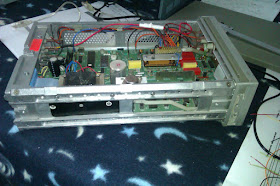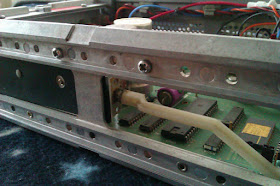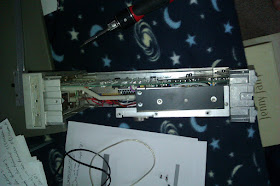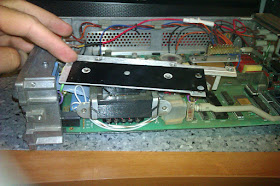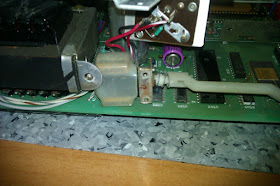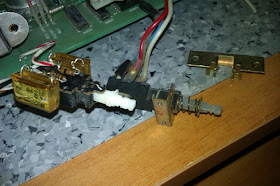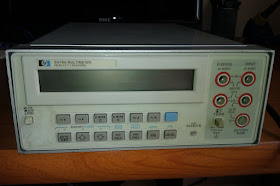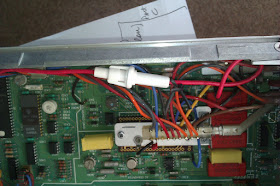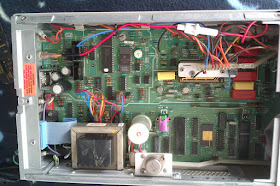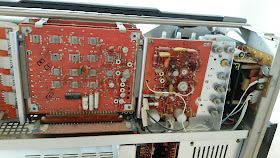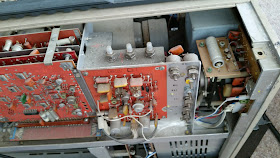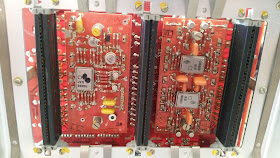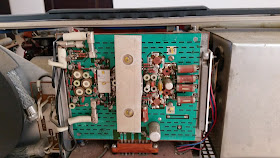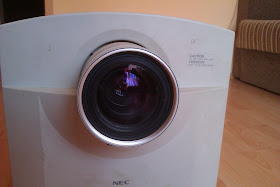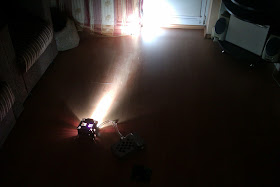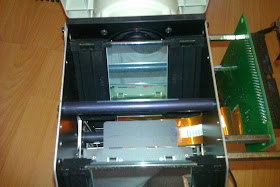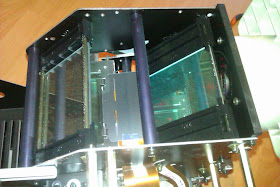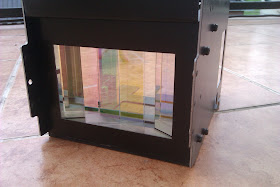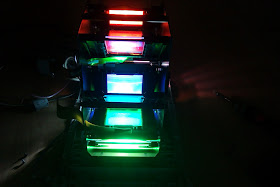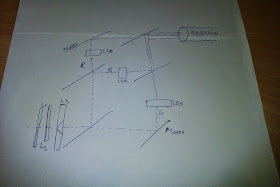Maybe some of you are wondering what's this doing here? What's up with this?
Well, in this section, I'll be posting reference design books, service and user manuals for test gear that I own, schematics and so on, both to create a library of data for myself and also to maybe help others that are searching for ideas, manuals....
So, let me start this off with a recommendation for those that are just starting with electronics and also for those that have the experience but never managed to read this book:
"The Art of Electronics" by Paul Horowitz and Winfield Hill - Second Edition
This is the go-to book if you're a student and also if you have some experience but having trouble with either understanding something or struggling with a design.
This edition is indeed old (1987-1988 I think) but most of it holds true even today, especially for the analog and linear chapters.
I will not be making a review of this book because there are way too many out there. Having read it myself, I think it is essential that every electronics engineer try to go through this so one can gain a basic understanding of all things electronics. It is by no means complete, and again, it is very old, but hey, it's cheaper that the Third Edition (if you know where to download it from wink! wink!) and it'll keep you busy for quite a while.
So, have fun reading, or just stay on this blog for a while longer and enjoy the eye candy.
Wednesday, July 22, 2015
HP 3478A Multimeter Power Button Fix
In the post about the HP 3478A Multimeter Modification, I said at one point that even though there's that issue about the stuck power switch, it doesn't bother me that much.
Well, it turns out that it did bother me. In fact it was down right annoying. Most likely because of my O.C.D. was acting up, knowing that there's something not quite right about the multimeter.
So, rummaging through my collection of old miscellaneous "things" I salvaged from different other devices people usually throw away (yes good people, sometimes, being a hoarder really pays off), I happened to find a spring power switch, which, in mind mind looked like a very good replacement for the one on the HP multimeter.
So, I quickly took the top cover off my 3478A, had a quick peek at the broken power button, and indeed, looked very much like the one I recently found. So, I naturally thought "well, OK, I'll replace it now....how hard cand it be....should't take more than half an hour, right?" Famous last words.
Took me a few minutes to figure out just how to take apart the 3478A to get to the power button. First, the side plate had to be removed, exposing the cast aluminium frame.
So, ignoring the very fashionable bed covers (that's how real engineers work....on beds and chairs and garages) the frame is held in place with four screws, one in each corner. Screwed to this frame piece is an aluminium plate that holds the transformer, a voltage regulator and also the infamous power switch.
After first unscrewing the three bolts that hold the aluminium plate, I then undid the four corner screws and took off the frame piece.
Nope, still not there just yet. The screws that hold the power button are now accessible, but to get the whole power button out, the plate also has to come off. For this, the two screws that hold the transformer to the plate need to be taken out also. Only after this, can the aluminium plate be lifted, thus giving access to the button.
If undertaking something of this sorts, take care how you handle the wires going to the regulator. Careful the solder doesn't crack or that you don't put too much stress on the wires themselves, because they might sometimes crack because of old age (although mine looked pretty good, despite the unit being built in 1991).
OK, pretty good so far. Now what? Well, take out the button, right? Out with the old, in with the new..er.
I took my trusty needle nose pliers, grabbed the shaft of the button and pulled it apart from the lever of the button than protrudes out from the front panel.
The, with a scalpel, I cut the shrink tube from around the power button and lo and behold...two capacitors and two resistors on the sides of the button...man, the guys at HP weren't stingy at all. Very nice bit of kit they built here. Annoying as hell because now I had to do even more work on it, but nice attention to detail.
This is the part where I started to take the replacement button and measuring it up along side the original and see if it really fits....Well, not really. The shaft of the replacement is about 5 millimeters longer and it also had a much wider metal plate on the front.
In the picture above you can see the solution. I took the metal bezel (front plate, call it what you will) from the original HP button and stuck it onto this. I don't know if it was divine intervention or just pure dumb luck, but somehow, I only has to file away about 1 millimeter so that the plate could snugly fit onto the new button. Also, in the picture above, you can see the original plate on the right, and the old plate already installed on the new button (new-ish, anyway).
The next steps may sound straight forward, but it took me about 30 minutes to do. After filing away the shaft so it would fit into the lever and then cutting the lever about 5 millimeters and also the shaft of the button another 5 millimeters, I took off (no, not desoldered, but "took off", as in "cut off") the capacitors and resistors from the old switch and soldered them to the replacement one.
The original HP switch was a Schadow, Type NE15, DPDT switch. The replacement was a DPST one, but that worked, since HP also used it in this configuration.
A quick mockup seemed promising as the button and the lever seemed to fit and more importantly, actually worked.
By the way, I didn't have shrink tube that large a diameter, so I put some electrical tape around the button to insulate it. May sound crude, may look even cruder, but it works and is also a very viable long term solution.
It may sound simple, all of this, but the whole taking the plate apart, figuring how to make the replacement button fit then soldering the wires and components to it, putting it back together, took a little over two hours.
So, fun as it was, this is one of those things that you'd only do once. But at least, in the end, I now have a fully functioning multimeter.
Tuesday, July 14, 2015
HP 3478A Multimeter Modifications
What kind of electronics engineer doesn't have a bench multimeter? Well, probably a lot, but since I didn't have any decent multimeter, aside from some very cheap UNI-T ones, I bought from eBay an old HP 3478A 5 1/2 digit multimeter.
It'd old, I know, but it was "really cheap" (about 120 Euros) and only had some minor faults. I mean, what's a stuck Power button and a missing AMPs range fuse, right?
So, anyhow, it arrived, I was thrilled when I got it and surprise surprise, it worked surprisingly well and gave very accurate readings (tested it against another, borrowed, Fluke handheld multimeter and it was very accurate).
And, now what? Well, the Power button was stuck in the "On" position, which is very convenient, so for now, until I can get a replacement switch, I'll just have to unplug it when its job is done. (the button is all rusty and full of crud)
I proceeded to put it through its paces and measured....stuff. I asked someone to lend me a Fluke DMM. Then, the rest was simple. For the DC volts, a home made, dual channel power supply, with 0-30 Volts on each channel proved very helpful and also a variable transformer for the AC volts helped, although, kind of tricky because the line voltage isn't really an ideal standard because of the constantly changing loading of the grid. The 2-wire and 4-wire Ohms also worked a treat.
I proceeded to put it through its paces and measured....stuff. I asked someone to lend me a Fluke DMM. Then, the rest was simple. For the DC volts, a home made, dual channel power supply, with 0-30 Volts on each channel proved very helpful and also a variable transformer for the AC volts helped, although, kind of tricky because the line voltage isn't really an ideal standard because of the constantly changing loading of the grid. The 2-wire and 4-wire Ohms also worked a treat.
As for the missing AMPS fuse....This thing has plugs in the back also, right? Which I'm not going to use, right? So, why not disconnect the wire from the front AMPS plug, run a fuse and a wire to some other pug to the rear terminals and that's it. So I did just that. I ordered a fuse-holder and some 3A 250V fast fuses, cut the original Amps range wire, spliced it with the fuse holder and Voila! A fully functioning bench multimeter.
Also, if someone's curious, yes, I checked the battery for the ROM that holds the calibration data and it was either changed or still has some life in it, because it read about 3.6 Volts.
Future thoughts - get a GPIB PCI card and start putting this little jewel to some good use in some automated tests for one of my projects I've been working on lately.
Future thoughts - get a GPIB PCI card and start putting this little jewel to some good use in some automated tests for one of my projects I've been working on lately.
Teardown of an old russian C1-91 100 MHz, 2 Channel Oscilloscope
I got this old relic for free from a very kind person, when I was still a student and working on my final year project. It's a great bit of kit, and, yes, it's a clone of the Tektronix modular scopes from the 80's, and yes, the labels are all in Russian, and yes, it takes 10 minutes for the CRT to actually show something....but hey, it did it's job.
But now, since I got my new Rigol 1054Z and because the trigger on the old C1-91 has been trowing fits, I figured that it was just taking up space. Plus I just couldn't find a spot in a corner somewhere where it could sit undisturbed and hot have to move it every time I cleaned my room / lab, because this thing is heavy....about 30 kilograms worth. So I decided I could do without it and maybe use the components inside for other things, like an oscilloscope clock for example.
So, taking after it's clone, the Tektronix 7000 series Mainframe oscilloscopes, it has three bays where one can mount different modules, from a two channel oscilloscope input module, to a multimeter module, signal generator modules and so on. I removed mine, then proceeded to disassemble it to it's bare bones. Easier said that done, and I'll explain why.
The people that designed this scope were either thinking, or blindly copied every detail from the Tektronix scopes. I, personally, since I haven't seen the insides of said Tektronox scopes, would like to believe the first option, that the russian engineers knew what they were doing.
Because the frame of the scope was all aluminium, it only makes sense that to avoid corrosion pr oxidation, same metal fastners have to be used. Therefore, all the screws on the aluminium parts were also made of aluminium. Which would be nice, if they weren't made from the softest alloy they could find. And when I say soft, I mean that by applying a bit of force to loosen the Phillips head screws was enough to mangle them and so, be stuck in place.
Oh well....where there's a hammer, there's a way.
The first thing one notices when taking such devices apart is how different they look. Back then, the Russians made their own electronic components (capacitors, resistors, diodes, transistors of all kinds, ICs), after their own liking and in the process, developed a style of their own, to laying out boards.
See what I mean. By the way, the square metal cans are actually hybrid circuits.
Trust me when I say it's weird. And don't even get me started on the schematic. In fact, as I'm writing this, I'm trying to figure out the schematics for this thing, so that I can turn it into a prototype for an oscilloscope clock and sincerely, not getting anywhere with it. I mean, they have all kinds of numbered wires going all over the place to numbered connectors. But the same wire has different markings on each end and each pair of connectors (from one board to another) also have different names, making things very frustrating and hard to read. A post with my efforts on the scope clock will follow at some point.
Until then, I leave you with the Picasa album with teardown pictures for this thing so you can admire this in its full glory and actually get a feel for how bulky this thing is and feels.
The first thing one notices when taking such devices apart is how different they look. Back then, the Russians made their own electronic components (capacitors, resistors, diodes, transistors of all kinds, ICs), after their own liking and in the process, developed a style of their own, to laying out boards.
See what I mean. By the way, the square metal cans are actually hybrid circuits.
Trust me when I say it's weird. And don't even get me started on the schematic. In fact, as I'm writing this, I'm trying to figure out the schematics for this thing, so that I can turn it into a prototype for an oscilloscope clock and sincerely, not getting anywhere with it. I mean, they have all kinds of numbered wires going all over the place to numbered connectors. But the same wire has different markings on each end and each pair of connectors (from one board to another) also have different names, making things very frustrating and hard to read. A post with my efforts on the scope clock will follow at some point.
Until then, I leave you with the Picasa album with teardown pictures for this thing so you can admire this in its full glory and actually get a feel for how bulky this thing is and feels.
Thursday, July 2, 2015
Teardown of old NEC MultiSync MT Projector
A few months ago I got my hands on an old NEC Projector from the local flea market for almost nothing (20 Euros or so).
Of course, after carrying up the stairs to my apartment, which is no mean feat, because this thing weighs about 30 kilos, I followed the normal procedure for such a nice piece of old "vintage" electronic gear, which was to stand back and admire it. Ain't she a beaty?
After getting my trusty screwdriver set out, first I wanted to see the lamp in this thing. Pretty ordinary for it's day, but what really surprised me was that it probably had been recently replaced - or so it said in the menu. Only 600 hours of run-time? What a score.
So why take apart a perfectly functional projector? Well, for one, the 640x480 maximum resolution this thing has isn't really of much use....for anything. Another reason is that it has lots of nice components which are worth much more than what I pain for it. But the main reason is curiosity. I just want to rip it open then drool over it while I try and figure out what everything does.
So, first thing, the lamp. Looks nice an beefy, and really nice thing that the High Voltage power supply for this works independently of the projector's "mother board". Of course I couldn't resist not playing with it.
Top notch job on this. Looks like the engineers that worked on this design did a really nice job. I mean, it did cost about 10.000 dollars new....back in the 90's.
In fact, this entire thing was really nicely engineered and with quality parts. Rubycon and Nichicon caps, Omron relays, really nice BNCs and connectors on the front. And also, a ton of quality optics in it.
After getting my trusty screwdriver set out, first I wanted to see the lamp in this thing. Pretty ordinary for it's day, but what really surprised me was that it probably had been recently replaced - or so it said in the menu. Only 600 hours of run-time? What a score.
So why take apart a perfectly functional projector? Well, for one, the 640x480 maximum resolution this thing has isn't really of much use....for anything. Another reason is that it has lots of nice components which are worth much more than what I pain for it. But the main reason is curiosity. I just want to rip it open then drool over it while I try and figure out what everything does.
So, first thing, the lamp. Looks nice an beefy, and really nice thing that the High Voltage power supply for this works independently of the projector's "mother board". Of course I couldn't resist not playing with it.
Top notch job on this. Looks like the engineers that worked on this design did a really nice job. I mean, it did cost about 10.000 dollars new....back in the 90's.
In fact, this entire thing was really nicely engineered and with quality parts. Rubycon and Nichicon caps, Omron relays, really nice BNCs and connectors on the front. And also, a ton of quality optics in it.
(FYI:That's in centimeters, not inches)
After making my way through the jungle of wires inside this thing, I finally got to the main power board. As I said, really nice design. No cheap Wan-Hung-Lo brand caps here, thank you very much.
Input filter, MOVs, this thing's got it all.
The board is mainly dedicated to the switch-mope supply, but there's also a smaller transformer, probably powering the analog part of the main logic board i.e the op-amps for the video output.
Also, notice the amount of EMI suppression this board has on it (especially the analog section), and also the forest of electrolytics scattered all over.
It took me the better part of a day to get to the metal chassis for the optics of the projector. Everything was either tied down with cable ties or screwed to something. Like I said...quality.
But once I got to the optics....
I spent another day carefully getting every mirror out and the trying to figure out how this thing actually produced an image.
And this is what I came up with:
Excuse the hand drawn schematic, but I really suck when it comes to expressing my inner artist.
Basically, the light from the lamp is split into three optical pathways, each corresponding to the colors Cyan, Magenta and Yellow. This is done with two dichroic mirrors. For those that don't know what a dichroic mirror is (don't worry, I didn't know either before this teardown), it's a mirror that only reflects a certain wavelength of light, while letting the rest of the spectrum to freely pass through it without much disturbance (i.e. reflections or refractions).
There are also two other "normal" mirrors that are there only to help guide the light to the main objective.
Now, after the colors have been separated, the image has to be produced somehow. This is where three LCD displays come in. The video data is taken from the input panel, then the processor splits that up into three colors, then sends each color channel data to the LCDs. The LCDs are almost transparent (they have a darkish tinge to them) so some light is lost at this stage. Also, in front of two of the LCDs there are polarizing filters - one vertical and the other horizontal. I haven't quite figured this part out yet, I don't know how they tie up in the final image.
From here on, all that;s left to do is join the three optical path with some clever use of optics into one beam, then send it on it's way to be projected on to whatever surface someone desires (as long as it's white).
Now, I'd like to mention that although it's much nicer for the eye to have this kind of splitting of the video data into three separate colors, it's expensive as you need a lot of quality optics. Also there is a lot of light lost because the dichroic mirrors do not reflect 100% of the light and because the LCDs are somewhat dark, so the final image looks really dim. So a lot of light is needed to be pumped into this thing to get a relatively ok picture on the other end.
So, that's why we're stuck with the color wheel in today's projectors that make you see stars every time you rapidly move your eyes when looking at a modern projector (or should I say the image projected by it)
If you would like to know more about the color wheel I mentioned, watch this video that Ben Krasnow made, detailing how modern projectors work. It's worth it, trust me.
For more information on this projector, you can visit: http://www.projectorcentral.com/NEC-MultiSync_MT.htm
Repair of Voltcraft DPS-4005PFC Power Supply - Part 1
About a year ago I bought and old Voltcraft DPS-4005PFC adjustable switchmode power supply, advertised as not working. It was missing the main controllers and also the two main switching transistors, but I thought I would give it a shot. I mean, if all else failed, I could rip out the rest of the bits in it and spin my own PSU.
I thought it was a nice bit of kit: 0-40 Volts and 0-5 Amps, PFC, a nice big LCD....
When I got it, I gave it a thorough visual inspection and the once-over with the DMM, to check for any burnt or missing components.
After it all checked out, I put it on a shelf somewhere, waiting to buy some 2SC2625 for it and see if it did anything (besides blowing up in my face).
A moth ago, I decided to buy the transistors. Got them, soldered them in, now, to test it.....But how?
Well, Arduino was the answer, of course.

I got the schematics out, identified the pins for the AD7541 DAC, wrote a quick and dirty code for it, and voila!, voltages on the output. Perfect.
Now, let's get the whole thing working. I mean the LCD, the rotary encoder, the buttons. the current limiting, the fan and, apparently, the fine voltage setting mode this thing has (I'll talk about this later)
So, back to the schematics. This thing used two micro-controllers to drive this thing. A Windbond W78C32B-40 to drive the LCD and do some EEPROM storage and an Atmel AT89C51 to do the rest of the control and housekeeping. So the Leonardo that I have hooked up to this thing isn't going to cut it. The plan is to get all the parts working, one by one, then buy a Mega and put it all together, into one code and fire this thing up (figuratively speaking, of course).
Just to see what it takes to drive this thing, below is a table with all the connections I need to hook up to get the PSU into working shape.

The pin assignment on the Mega is mostly chosen randomly, so they will probably change by the time I get it into final shape.
So, let's get to the interesting part. First off is the encoder and output relay. Simple things.
For the encoder, I used the library from this site. It's very easy ans simple to use and it worked first time, without any headaches.
Next, was the LCD. Boy, did that ever got me frustrated. It's simple, if you read the datasheet, but who has time for that. The chipset for the LCD is the PCF8576.
I did a quick search for anyone else thet had to deal with this controller, and there were some references and some code available, so I didn't had to start from scratch.
It's nice that it's an I2C device, so it was easy to wire in (of course I mixed up the SDA and SCL pins the first time)
Because the LCD has 4 backplanes, the setup for this LCD is 1:4 drive mode, with 1/3 bias configuration. That means, that if you start sending it data starting from address 0x00 (B00000000), each consecutive byte of data will increase the address counter in the PCF8576 by 2. This took me a while to get used to. Also, I made it more complicated because I actually wanted to understand how this thing works, so I got out an A3 paper, made a copy of the LCD segments on it and started feeding it address and data bytes (please excuse the bad hand writing).
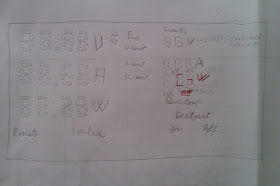
At first, I had no clue what I was doing and luck would have it, I started with an odd address value, which gave me the weirdest results: a byte controlled the segments on half a digit and half on the adjacent digit.

After a few frustrating hours, I eventually got fed up with this, started from address B00000000 and fed it about 20 bytes of data and lo and behold, the whole LCD lit up, AWESOME!
An hour later I had all the individual LCD segments mapped out.
#include <Wire.h>
#define ADDRESS B0111000 // I2C Address of PCF8576
#define DEVICE_SELECT B11100000 // Device select [Command] [1100] [A2 A1 A0]
#define MODE_SET B11001000 // MODE SET [C] [10] [LowPower] [Enable] [Bias] [Mux]
#define BANK_SELECT B11111000 // no effect in 1:4 multiplex mode
unsigned long time;
unsigned long time_now;
void setup()
{
}
void loop()
{
Wire.begin(); // join i2c bus (address optional for master)
delay(1000); //allow lcd to wake up
Wire.beginTransmission(ADDRESS); //adress the upper I2C-controller.
// delay(2);
Wire.write(MODE_SET); //MODE SET (Command)(10)(LowPower)(Enable)(Bias) (Mux)
// (1) (0) (1) (ΩBias) (1:2)
Wire.write(DEVICE_SELECT); //Device select (Command)(1100)(A2 A1 A0)
// (1) (0 0 0 )
Wire.write(BANK_SELECT); //Bank Select (Command)(11110)(Input)(Output)
// (1) (0) (0)
Wire.write (B00000000) ; //Address - starts gro 0x00
Wire.write (B11111011) ; //5 and limits and dots and Output//A-0
Wire.write (B11111111) ;//6 and i-const //A-2
Wire.write (B11111111) ;//9 and remote //A-4
Wire.write (B11111111) ;//10 and locked //A-6
Wire.write (B11111011) ;//11 and p-const //A-8
Wire.write (B11111010);//12 and W //A-10
Wire.write (B00000000); //Overtemp, ON, 18 and 19 //A-12
Wire.write (B11011011);//20 and w // A-14
Wire.write (B11111100);//18 and 19 // A-16
Wire.write (B11110110); // Off, 15 and 16 // A-18
Wire.write (B11101011);//17 and a // A-20
Wire.write (B11111011);//15 and 16 // A-22
Wire.write (B11111011);//14 and v // A-24
Wire.write (B11111011); //13 //A-26
Wire.write (B11111011);//4 and V // A-28
Wire.write (B11111011); //3 and up arrow // A-30
Wire.write (B11111011); //2 and down arrow // A-32
Wire.write (B11011101); // 1 and fine // A-34
Wire.write (B11111011); //8 and A // A-36
Wire.write (B10111011); //7 and u-const // A-38
Wire.endTransmission();
}
#define ADDRESS B0111000 // I2C Address of PCF8576
#define DEVICE_SELECT B11100000 // Device select [Command] [1100] [A2 A1 A0]
#define MODE_SET B11001000 // MODE SET [C] [10] [LowPower] [Enable] [Bias] [Mux]
#define BANK_SELECT B11111000 // no effect in 1:4 multiplex mode
unsigned long time;
unsigned long time_now;
void setup()
{
}
void loop()
{
Wire.begin(); // join i2c bus (address optional for master)
delay(1000); //allow lcd to wake up
Wire.beginTransmission(ADDRESS); //adress the upper I2C-controller.
// delay(2);
Wire.write(MODE_SET); //MODE SET (Command)(10)(LowPower)(Enable)(Bias) (Mux)
// (1) (0) (1) (ΩBias) (1:2)
Wire.write(DEVICE_SELECT); //Device select (Command)(1100)(A2 A1 A0)
// (1) (0 0 0 )
Wire.write(BANK_SELECT); //Bank Select (Command)(11110)(Input)(Output)
// (1) (0) (0)
Wire.write (B00000000) ; //Address - starts gro 0x00
Wire.write (B11111011) ; //5 and limits and dots and Output//A-0
Wire.write (B11111111) ;//6 and i-const //A-2
Wire.write (B11111111) ;//9 and remote //A-4
Wire.write (B11111111) ;//10 and locked //A-6
Wire.write (B11111011) ;//11 and p-const //A-8
Wire.write (B11111010);//12 and W //A-10
Wire.write (B00000000); //Overtemp, ON, 18 and 19 //A-12
Wire.write (B11011011);//20 and w // A-14
Wire.write (B11111100);//18 and 19 // A-16
Wire.write (B11110110); // Off, 15 and 16 // A-18
Wire.write (B11101011);//17 and a // A-20
Wire.write (B11111011);//15 and 16 // A-22
Wire.write (B11111011);//14 and v // A-24
Wire.write (B11111011); //13 //A-26
Wire.write (B11111011);//4 and V // A-28
Wire.write (B11111011); //3 and up arrow // A-30
Wire.write (B11111011); //2 and down arrow // A-32
Wire.write (B11011101); // 1 and fine // A-34
Wire.write (B11111011); //8 and A // A-36
Wire.write (B10111011); //7 and u-const // A-38
Wire.endTransmission();
}
I've put comments next to each data byte regarding what digit number o character they encode, after my own notation, of course. Here are the pics with the corresponding character numbering:
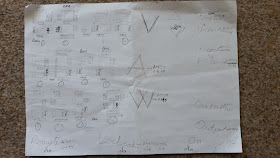

There are two mappings because I've split up the screen into two areas so I would have more space on a single A4 paper. The first pic is of the left side of the display, where the main voltage, current and power reading are displayed and also other characters like the "Limits", "V", "A", "W" characters, etc.
The second pic is of the right side of the display, with the limits settings. Underneath each digit or character is the number I assigned to it and corresponds to the numbers in the Arduino code.
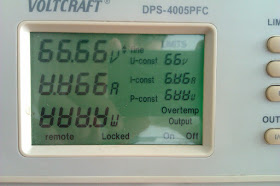
Looks better now, doesn't it? And yes, it was supposed to look like that i.e. "6"s and inverted "A"s.
And now a quick explanation of how the bits map out in a byte.
Say you have:
The address is 0x22 which is 32 in decimal. The bits from 0 to3 and 5 to 7 map out segments of a digit (in this case digit 1) while the 4th bit is for a character on the screen (in this case "Fine")
So, at address 0x22, bit 0 set to "1" turns on segment D of digit 1 (which according to my hand drawn diagram of the LCD is the left most digit on the first row). Bit 4 set to "1" will turn on the "Fine" symbol and bit 7 set to "1" will turn on segment B of digit 1.
Hope this makes some sense. If not, you can always leave a comment or contact me via my Facebook page: https://www.facebook.com/ElectronicsPlayground?ref=hl
Also, there's going to be some updates coming, once I put everything together on the Arduino Mega and move the actual code on it.
